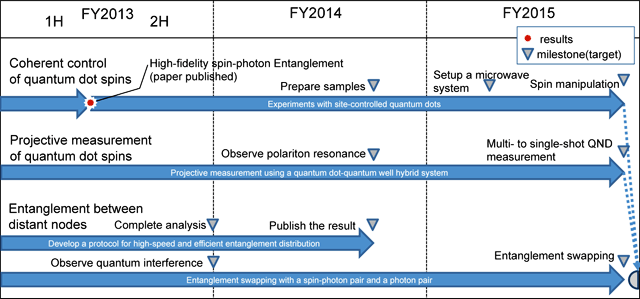
Subject B : Entanglement purification between distant nodes
158B-T02Quantum repeater based on optical-pulse-controlled quantum dot spins and single photons
Stanford University / National Information of Informatics
(Yoshihisa Yamamoto)
The two essential components of a quantum repeater system are (i) photons transmitting information between distant nodes and (ii) stationary quantum memories at the respective nodes. The latter requires both long coherence time and efficient optical interfacing, for which single spins in optically bright quantum dots based on III-V semiconductors are promising candidates. Using ultrafast optical pulses and high magnetic fields, we are able to control, coherently and completely, a single quantum dot spin within a few tens of picoseconds. Further, the use of spin echo technique allows for hundreds of thousands of gate operations within the coherence time. With these abilities in hand, our project aims to (i) demonstrate entanglement between a single quantum dot spin and a single photon, and (ii) generate entanglement between a single spin and single photon in distant nodes, heralded by the coincidence detection of two indistinguishable single photons emitted from the respective nodes. Realization of the spin-photon entanglements will be major steps on the way toward a satellite-based quantum repeater.
Along with these experimental efforts, we carry out theoretical study on (i) methods for implementing quantum logic gates and projective measurements in a quantum dot system, (ii) protocols for high-speed and efficient entanglement generation between distant nodes using an intermediate EPR photon-pair source, (iii) designs for fault tolerant quantum repeater/computer architecture, and so on. In all cases we take realistic situations such as errors in the quantum memories and optical losses in the communication channel into account so that our theoretical analysis can be immediately reflected in our experiments.
The following subthemes are pursued.
- Subtheme 1: Coherent control of quantum dot spins
- Benchmark the fidelities of initialization and single-qubit operation, develop techniques to reduce decoherence, and propose schemes for multiple-qubit operation
- Subtheme 2: Wavelength-conversion technology
- Develop technology for single-photon wavelength-conversion from 0.9 um (wavelength of photons from quantum dots) to 1.5 um (compatible with low-loss optical fiber channel) using a periodically-poled lithium niobate (PPLN) waveguide device
- Subtheme 3: Spin-photon entanglement
- Demonstrate high-fidelity entanglement between a single quantum dot spin and a single photon
- Subtheme 4: Projective measurement of quantum dot spins
- Develop a technique for multi- to single-shot quantum non-demolition (QND) readout of a spin state, using Faraday geometry and possibly an additional ancillary state (realizing a cyclic transition) or an exciton-polariton resonance.
- Subtheme 5: Entanglement between distant nodes
- Demonstrate entanglement between a single spin and single photon in distant nodes, heralded by the coincidence detection of two indistinguishable single photons emitted from the distant nodes.
The relation among the subthemes are as follows; The results from subthemes 1 and 2 will be directly used to demonstrate the mid-term goal (subtheme 3). Then they will be combined with the result from subtheme 4 in order to achieve the project goal (subtheme 5).
Interim results for Team 158B-T02
| Task title | Outcome | Date | Note |
|---|---|---|---|
| 1: Coherent control of quantum dot spins | (i) Schemes for two-qubit logic gates for quantum dot spins are proposed. (ii) A design for layered quantum architecture is proposed. | Dec. 2011, Jun. 2012, Jul. 2012 |
(i) Phys. Rev. B 84, 235307 (2011); Phys. Rev. B 85 241403 (2012); (ii) Phys. Rev. X 2, 031007 (2012) |
| 2: Wavelength-conversion technology | Downconversion quantum interface for a quantum dot spin and low-loss optical channel is realized. | Nov. 2012 | Opt. Exp. 20, 27510 (2012) |
| 3: Spin-photon entanglement | High-fidelity spin-photon entanglement is generated. | Nov. 2012, Jul. 2013 |
Nature 491, 421 (2012) Nat. Commun. 4, 2228 (2013) |
Targets for Team 158B-T02
| Task title | Work/Milestone | Due Date | Note |
|---|---|---|---|
| 1: Coherent control of quantum dot spins | a) Prepare electron-doped site-controlled quantum dot samples and demonstrate their capabilities of generating single photons and tuning Zeeman frequencies | Dec. 2014 | |
| b) Spin manipulation in site-controlled quantum dots using either optical or microwave pulses | Mar. 2016 | ||
| 4: Projective measurement of quantum dot spins | a) Prepare planar cavity samples containing both quantum dots and a quantum well, and observe the shift of the dot emission wavelength due to the polariton resonance | Dec. 2014 | |
| b) Test multi- to single-shot QND measurement of the spin state via the polariton resonance in Faraday geometry | Mar. 2016 | ||
| 5: Entanglement between distant nodes | a) Develop a protocol for high-speed and efficient entanglement distribution compatible with satellite-based communication | Dec. 2014 | |
| b) Demonstrate entanglement swapping using an entangled spin-photon pair from a quantum dot and an entangled photon pair from a parametric down-converter | Mar. 2016 |

Chart 1Schedule for Team 158B-T02